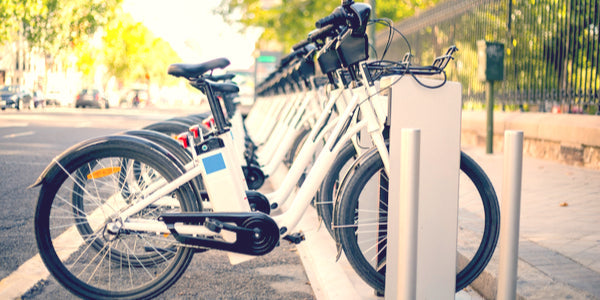
From in-home Peloton workout sessions to storefront cycling classes, biking has come a long way from a casual stroll in the neighborhood.
One of the newest biking endeavors to hit the fitness scene is the electrical bicycle, aka an e-bike. Which, as the name suggests, uses electric assistance to put the pedal to the metal.
But what makes an e-bike so special? Should one might consider trading in a traditional bike with one sporting an electric motor?
Let’s take a more refined look at their differences and consider the pros and cons of each!
How Does an E-Bike Work?
An electric bicycle, aka e-bike, contains an electrical drive system including a battery and motor. This is a way to integrate the hub motor’s power to the driver, and a way for the driver to control that power.
Basically, these bikes have a battery-powered pedal assistant, and some even have a throttle. This provides riders a boost to climb steep hills and journey tough terrain without feeling completely gassed.
Electric bikes ride fast thanks to the jolt of extra help, and just like on a regular bike, faster pedaling equals quicker speed. Also similar to a human-powered bicycle, many e-bikes include a power switch to adjust the boost magnitude. However, most do not top a speed of 20 to 28 miles per hour.
Best Features of an E-Bike
Some hardcore bike riders and exercise enthusiasts have criticized riding on e-bikes because they reduce the heart-pumping, beneficial effects of conventional bicycles. While this is true to some extent, biking of any form is better than using a transportation method that requires zero effort such as a car!
E-bikes can replace driving which can result in a more favorable environment due to reduced carbon emissions and potentially a reduction in obesity and associated comorbidities. By far, this is the best feature! Plus, the batteries continue to improve, providing room for them to become even more environmentally friendly.
How Is a Regular Bike Different?
Besides the electric drive system that boosts the power potential of the bike and (sometimes) a display screen, e-bikes are not very dissimilar to their counterpart. Both have the same style of wheels, handlebars, and frames, and the mechanical parts like the pedals and brakes function the same.
Regular or road bikes, however, will feel like they require slightly more effort to pedal. Without the electrically powered boost, human legs and glutes produce the power needed to propel a bike forward. Thus, standard bicycles will certainly benefit health goals much more than the electric version.
Here are some of the top ten benefits of regular cycling:
1. Improves mental well-being
2. Promotes weight loss
3. Helps build muscle
4. Improves respiratory function
5. Reduces the risk of some chronic conditions like heart disease and cancer
6. Helps prevent bone injuries because of its low impact
7. Promotes better sleep
8. Boosts brain power
9. Enhances handling and spacial awareness
10. Strengthens the immune system
Finally, many avid cyclists tout the comradery and ability to grow their social circle as the greatest benefit of all!
Is One Better than the Other?
Whether an electric bike vs a regular bike is better really depends on someone's individual goals and priorities.
For example, an e-bike would be better for someone looking to purchase it for the purpose of commuting miles to work without sweating (as badly). A regular bike, however, might be best for one looking to stay physically fit via biking.
A few more examples include the following lists.
An electric bike is better for the person who:
• Wants an eco-friendly transport method
• Prefers leisure movement more than high intensity
• Needs a bike more sturdy than a regular one
• Desires to cycle faster (r/t the boost of help)
A regular bike is better for the person who:
• Wants the most eco-friendly transport method
• Prefers more strenuous exercise
• Needs a light apparatus that’s easily transportable
• Wants their own (muscular) power to produce force
Electric Bikes vs. Regular Bikes: The Conclusion
E-bikes and regular bikes are not really that different after all. Beyond the electric power boost on the e-bike, they look and perform nearly the same.
Between the two, the bike that will serve you best is dependent on your goals and intentions of use. Using the criteria above, choose the option most fitted to your style and cycle on!
References:
Arthurs-Brennan, Michelle. 15 Benefits of Cycling: Why Cycling Is Good for Weight Loss, Fitness, Legs and Mind. Cycling Weekly. www.cyclingweekly.com/news/latest-news/benefits-of-cycling-334144.
Aventon Bikes. Electric Bikes vs Regular Bikes: What's the Difference? Aventon Bikes. www.aventon.com/blogs/aventon_bikes/electric-bikes-vs-regular-bikes-whats-the-difference.
Krug, Frances. Electric Bikes vs. Regular Bikes: What's The Real Difference No One Talks About. EVELO. evelo.com/blogs/learn/electric-bikes-vs-regular-bikes-what-s-the-real-difference-no-one-talks-about.
Yeager, Selene. 13 Reasons to Get Seriously Stoked About E-Bikes. Bicycling. www.bicycling.com/skills-tips/a20044021/13-things-about-e-bikes/.







